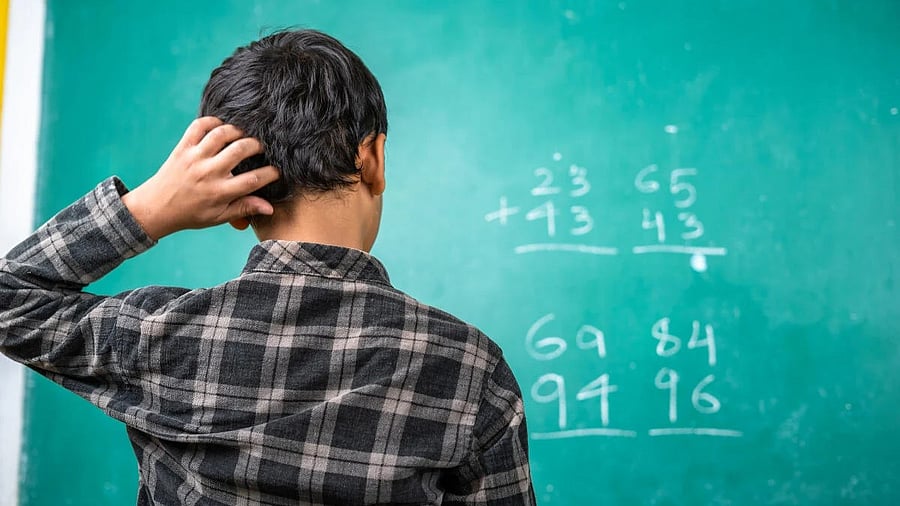
A representative image. Among the most striking revelations of the PARAKH survey is Gujarat’s below-average performance, despite its long-standing reputation as a model of development.
Credit: Getty Images
India’s journey towards a ‘Viksit Bharat @2047’, the centenary goal of becoming a developed nation, hinges on building a knowledge-driven economy powered by innovation, technology, and skilled human capital. With projections of reaching a $30 trillion GDP, education stands at the core of this vision, not merely as a social necessity but as the engine of sustained growth.
Yet, five years into the National Education Policy (NEP) 2020, aimed at fostering competency-based learning, the PARAKH Rashtriya Sarvekshan 2024 report has flagged persistent learning gaps and regional disparities that threaten to undercut India’s demographic dividend and long-term competitiveness.
The challenge before policymakers, economists, and educators is not just to align policies with ambition, but to ensure equitable, high-quality learning that can transform the world’s largest youth population into the driving force of India’s future prosperity. Achieving this will require sustained investment in research and skills training, stronger public-private partnerships, and innovative digital education models that reach even the most remote corners of the country. Without decisive action now, the promise of ‘Viksit Bharat’ risks becoming a missed opportunity.
Alarming findings
The report has exposed deep cracks in India’s education system, showing that while students begin their schooling with modest success, performance declines sharply as they move to higher grades. At the foundational level, Class 3 students scored an average of 64% in language and 60% in mathematics, reflecting basic competencies. By Class 9, however, these averages plummeted to 52% in language and just 38% in mathematics, pointing to severe learning deficits. Gender gaps are clear, with girls consistently excelling in language, while boys manage a slight edge in mathematics at higher levels.
The urban-rural divide, modest at the primary stage, widens noticeably from Class 6 onwards, with urban students pulling ahead. Regional disparities are particularly striking. Punjab, Kerala, and Himachal Pradesh emerged as high achievers across most grades and subjects, while States facing socio-economic challenges, such as Jharkhand, Bihar, Meghalaya, and several Northeastern districts, struggled to cross even the 50% mark in mathematics and science. Though rural children sometimes matched urban peers at the foundational stage, this early advantage vanished in higher grades, underlining a persistent and widening academic gulf across India.
Education funding and teacher shortage
India’s vision of holistic development relies heavily on education as the foundation for economic growth and a skilled workforce. However, this vision clashes with ground realities marked by significant teacher shortages and chronic underfunding.
Despite high expectations from teachers to act as facilitators of competency-based and inclusive learning, India faces over 700,000 vacancies in elementary teaching positions and around 120,000 in secondary education. Teachers are overburdened, and schools, especially in rural and underserved regions, struggle with inadequate staffing. This shortage hinders personalised attention and innovative pedagogical approaches vital for student engagement and skill development.
Compounding this challenge is the persistent underinvestment in education, with actual spending stuck at about half of the 6% of GDP target set by the NEP 2020. Without sufficient funding, critical reforms such as teacher training, digital education expansion, and infrastructure upgrades remain under-resourced.
Holistic development cannot be achieved in an education system hampered by these systemic deficits. Quality education demands both well-trained and adequate numbers of teachers, as well as sufficient fiscal commitment for learning resources, infrastructure, and technology integration.
Gujarat’s growth paradox
Among the most striking revelations of the PARAKH survey is Gujarat’s below-average performance, despite its long-standing reputation as a model of development. Only 52% of Class 3 students mastered basic mathematics, compared to the national average of 60%, while language scores and higher-grade outcomes also lagged, with several districts ranking among the lowest performers.
This stark underachievement highlights the imbalance in Gujarat’s growth story, which has prioritised economic and infrastructure expansion while underinvesting in human capital. Replicating such a model at the national level risks creating fragile development, driving GDP growth without laying the educational foundations essential for sustained progress.
The path to Viksit Bharat remains clear, but undeniably steep. Building a knowledge-driven economy will require consistent investment in research, fair distribution of resources, stronger public-private partnerships, and improved digital access in even the most remote corners of the country.
Above all, education must be treated as the backbone of India’s development journey. Unless urgent reforms and bold policy measures are undertaken, the nation risks extending the ‘Gujarat paradox’ to a national scale, achieving industrial and economic success without a sufficiently skilled workforce.
To truly realise the 2047 vision, India must align its economic ambitions with robust educational advancement, ensuring inclusive growth, and long-term prosperity.
Atman Shah is assistant professor, Department of Economics, St. Xavier’s College (Autonomous), Ahmedabad.
(Disclaimer: The views expressed above are the author's own. They do not necessarily reflect the views of DH.)